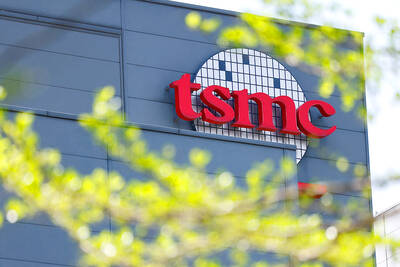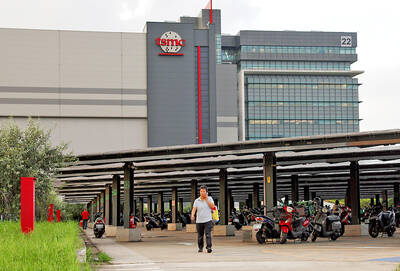Many local foodies have had a love-hate relationship with Texas Roadhouse, a US-based steakhouse chain, since the brand opened its first outlet in Taipei in late October on the third floor of Breeze Song Gao department store (微風松高) in Xinyi District (信義).
The popularity of the Taipei outlet — the chain’s first in Asia — has often seen customers waiting in line at weekends, with some patrons complaining on the restaurant’s Facebook page about reservation difficulties during its first month in operation.
Texas Roadhouse Inc global development group vice president Hugh Carroll attributed the restaurant chain’s good start here to similarities between Taiwanese and US consumers.
“I am very familiar with the Taiwanese market,” Carroll, who has lived in Taiwan, said during an interview in Taipei last month.
Carroll said Taiwan and the US have many traits in common, including families that enjoy eating out at a “fun” restaurant, which led to the easy acceptance of the American-style restaurant.
On top of good food, incorporating “fun” is important for building Texas Roadhouse’s brand, he said.
Edgar Lee, a 32-year-old Taiwanese who lived in the US for three years while working on his masters degree, said the cost-to-performance ratio, fun atmosphere and high quality of beef made Texas Roadhouse one of his favorite restaurants in the US.
“I usually went to Texas Roadhouse for dinner with friends every one or two months,” Lee said.
From its first outlet in Clarksville, Indiana, which opened in 1993, Texas Roadhouse has grown to more than 440 restaurants in the US.
The NASDAQ-listed company reported sales of US$1.18 billion in the first three quarters of this year, an increase of 13 percent from the same period last year.
“My [original] goal was to own not just a family restaurant and not just a steak restaurant, but a place where everyone, of all ages, could come and have a great meal and great fun, for a great price,” Texas Roadhouse founder, chairman and chief executive officer Kent Taylor, told the Taipei Times.
With an average customer spending between US$15 and US$20, the chain says that everything on the menu is made from scratch, with a butcher hand-cutting every steak and freshly baked bread available every five minutes.
In the hope of increasing interactions between restaurant employees and customers, and developing the “fun” theme, Texas Roadhouse has come up with a novel celebration for customers spending their birthday or wedding dinner at the restaurant: The customers are invited to sit on a saddle, while everyone else in the restaurant gives them a big “Yeehaw.”
The company has a goal to open 25 to 30 new stores in the US per year, which would expand the total number of its outlets to between 700 and 800 stores in the next 10 years, Taylor said.
In addition, Texas Roadhouse aims to develop itself into a world-class steakhouse chain through overseas expansion, he said.
The company has opened stores in Taiwan, Dubai and Kuwait through the franchise model.
It plans to enter the markets in Abu Dhabi and the Philippines by the end of this year, with Canada and Mexico to follow next year, Taylor said.
Roadhouse Restaurants Taiwan Ltd (路德斯) — the operator of Texas Roadhouse in Taiwan and a unit of Bayshore Pacific Hospitality Ltd (北軒餐飲管理) — is scheduled to open seven to 10 stores in Taiwan within the next five to seven years, with the Greater Taipei area to be its major market.
The second outlet in Taipei is set to open for business tomorrow at Minsheng Community (民生社區) in uptown Taipei.
As for China, which has a big consumer market and growing demand for beef, Bayshore Pacific president and chief operating officer Merritt Croker said the company is looking to continue cooperation with the US steakhouse chain to eventually introduce Texas Roadhouse there, given its experience and strength in developing the brand in Taiwan.

TECH TITAN: Pandemic-era demand for semiconductors turbocharged the nation’s GDP per capita to surpass South Korea’s, but it still remains half that of Singapore Taiwan is set to surpass South Korea this year in terms of wealth for the first time in more than two decades, marking a shift in Asia’s economic ranks made possible by the ascent of Taiwan Semiconductor Manufacturing Co (TSMC, 台積電). According to the latest forecasts released on Thursday by the central bank, Taiwan’s GDP is expected to expand 4.55 percent this year, a further upward revision from the 4.45 percent estimate made by the statistics bureau last month. The growth trajectory puts Taiwan on track to exceed South Korea’s GDP per capita — a key measure of living standards — a

Samsung Electronics Co shares jumped 4.47 percent yesterday after reports it has won approval from Nvidia Corp for the use of advanced high-bandwidth memory (HBM) chips, which marks a breakthrough for the South Korean technology leader. The stock closed at 83,500 won in Seoul, the highest since July 31 last year. Yesterday’s gain comes after local media, including the Korea Economic Daily, reported that Samsung’s 12-layer HBM3E product recently passed Nvidia’s qualification tests. That clears the components for use in the artificial intelligence (AI) accelerators essential to the training of AI models from ChatGPT to DeepSeek (深度求索), and finally allows Samsung

READY TO HELP: Should TSMC require assistance, the government would fully cooperate in helping to speed up the establishment of the Chiayi plant, an official said Taiwan Semiconductor Manufacturing Co (TSMC, 台積電) yesterday said its investment plans in Taiwan are “unchanged” amid speculation that the chipmaker might have suspended construction work on its second chip packaging plant in Chiayi County and plans to move equipment arranged for the plant to the US. The Chinese-language Economic Daily News reported earlier yesterday that TSMC had halted the construction of the chip packaging plant, which was scheduled to be completed next year and begin mass production in 2028. TSMC did not directly address whether construction of the plant had halted, but said its investment plans in Taiwan remain “unchanged.” The chipmaker started

LOOKING BRIGHT: Taiwanese tech stocks have been trading at 18 to 19 times earnings, beating the 15 percent long-term average amid AI-driven optimism, an analyst said Taiwan’s economy could expand by as much as 5 percent this year, fueled by its technology manufacturing edge amid a global artificial intelligence (AI) boom, while tariff exemptions on semiconductor products keep the country’s levy burden low despite a headline rate of 20 percent, UBS Investment Bank said yesterday. “Although Washington has imposed a 20 percent tariff on goods from Taiwan, exemptions for semiconductors keep the weighted average low,” UBS senior economist for Asia and China William Deng (鄧維慎) said. The growth momentum is expected to extend into next year, with technology companies’ revenue projected to rise 17 percent, UBS research head